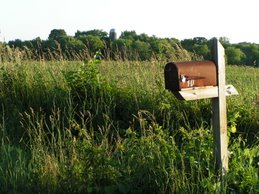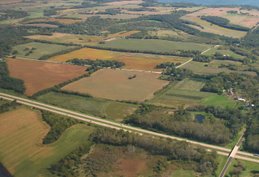Jan. 10, 2008 Letter to the Editor, Fitchburg Star
Submitted by Rosanne Lindsay, Fitchburg
Call it what you will, but the proposed Sveum development, on the outer edges of Northeast Fitchburg, is SPRAWL by any name, and raises more questions than it offers answers.
This plan may boast many things, including parks, rain gardens, native plantings, and filling a need to “provide houses in an area that reduces commuting distance” (for whom I might ask)? What it does not do is tell Fitchburg residents who care about increased taxes, what they will pay to provide services (water, sewer, fire, etc) to the NE area. Nor does it convey to those who care about protecting our natural resources, how these measures will be enforced.
The need for “greening” this plan was prompted by concerned citizens who believe that runoff pollution from this development will irreversibly degrade the native fauna and flora, creeks, springs, the Northern Pike Fishery, Lake Waubesa, and one of the highest quality and diverse wetlands in southern Wisconsin, only one mile from the site.
While Mr. Sveum’s effort to respond to citizen concerns was noted by some on the Plan Commission, discussion of specific measures by Sveum to address risks to the basic water chemistry and aquatic habitat conditions on pre-existing water bodies (Swan Creek, Lake Waubesa, Deep Spring), was lacking. These risks have been noted to be high and growing, according to Environmental Toxicologist, Dave Zaber (See 11/16/06 Star article).
Mr. Sveum’s consultant predicted that Swan Creek will not be adversely affected by development and that surface runoff will be cleaner than current conditions. However, he did not talk about accountability. In fact, Sveum et al. admitted that compliance with infiltration on individual lots cannot be enforced so how are we assured that groundwater recharge will be maintained or that runoff and the water bodies will remain clean?
There are accountability mechanisms which should be insisted upon: Sveum’s proposed Northeast Neighborhood, like his Harlan Hills, and Swan Creek developments contrast with the very rigorous accountability mechanisms that Bill Linton imposed in the Fitchburg Center. There, independent associations oversee the management and monitoring of compliance with covenants, much like the Natural Heritage Land trust does for PDR easements in the area.
In Harlan Hills, no additional funds will be provided to restore promised prairie land which is overwhelmed by clover. Mr. Sveum seeded and maintained the prairie for 2 years. Unfortunately, prairie restoration needs 3-5 years of maintenance to ensure proper generation of prairie plants, according to local experts. Promises of “no lawn pesticide application” (to protect the Arboretum) became “certain pesticides acceptable.” And even banned pesticides are sometimes applied because there is little, if any, ability to enforce.
As a result of the heavy rains last August, the Village of Oregon is faced with purchasing several flood-damaged homes, at least partly at taxpayer expense. The homes are downhill from Oregon's new Bergamont and Alpine Valley developments. Some have accused the developers of "design error" from poor stormwater management plans. Others say the developers are not to blame because they complied with the stormwater ordinance and other village requirements. Either way, there is little doubt that the developments exacerbated Oregon's pre-existing flood problems, as some residents had predicted.
These local histories prove that good intentions and inadequate city policies are simply not enough. Maintaining our precious environmental resources--the forests, prairies, wetlands, fisheries, and lakes that make living here so desirable--requires nothing less than full commitment to do whatever it takes to accomplish the goal, be it prairie restoration or preserving Swan Creek and the Lake Waubesa watershed.
Developers can talk all they want about "sustainability" and "green" development but they often fail to follow through. So it must be the city’s job to probe for specifics and examine concerns raised previously about the developer's Northeast Neighborhood Plan, including the suitability of the model being used for hydrological impacts, the absence of cumulative effects analysis, the preservation of rare hydric soils and infiltration, and the threats to our aquifer (groundwater) from a burgeoning population, as described by UW Ecologist Cal DeWitt.
Mr. Sveum also gave the rosy economic prediction that his thousand-home development will not cost the city money. But will Mr. Sveum give the city an enforceable guarantee as the country heads toward a recession? Or will Fitchburg taxpayers be the ones who bear the cost when his prediction proves incorrect? Virtually all Cost of Urban Service studies show that residential development leads to a net drain on local government budgets. What justifies Mr. Sveum’s belief that his Northeast Neighborhood development will be any different? What about reality of the nation’s economy; the shortage of credit to homebuyers resulting from the mortgage meltdown, the perceived need for more housing when many homes stand empty waiting for a buyer, or the fall of the dollar? City officials should require a full Cost of Urban Services Study for all new development proposals as a matter of fiscal responsibility.
The public policy question is one of deciding whether or not “market forces” should allow this sort of development at this location when it makes such a dramatic influence on the area’s natural and recreational resources, as well as contributes to commuter traffic and sprawl. The fact that there is the rail line and the Green Tech Village plan, both of which do far more for the City, is an important alternative that must be given more thought.
Proposed developments, in conjunction with past and present developments, are adversely affecting groundwater and surface water resources throughout Dane county and this problem is particularly acute in this part of Dane County. Let's hope that at future meetings of both the Plan Commission and the Common Council, the city will ask many probing, skeptical questions that will truly serve the interests of the many Fitchburg residents waiting for answers.
And while Mr. Sveum may, indeed, share many of our concerns, he may be the only one to see “green” if the Northeast Neighborhood turns into more Fitchburg SPRAWL.
Thursday, January 10, 2008
'Green Plan' is Actually SPRAWL
Posted by
Terry Carpenter
at
12:28 PM
![]()
Categories Cal DeWitt, Growth, Letters to Editor, NE Neighborhood Plan, NEN, NEN Stormwater Plan, Plan Comm Meetings, Water Resources



No comments:
Post a Comment